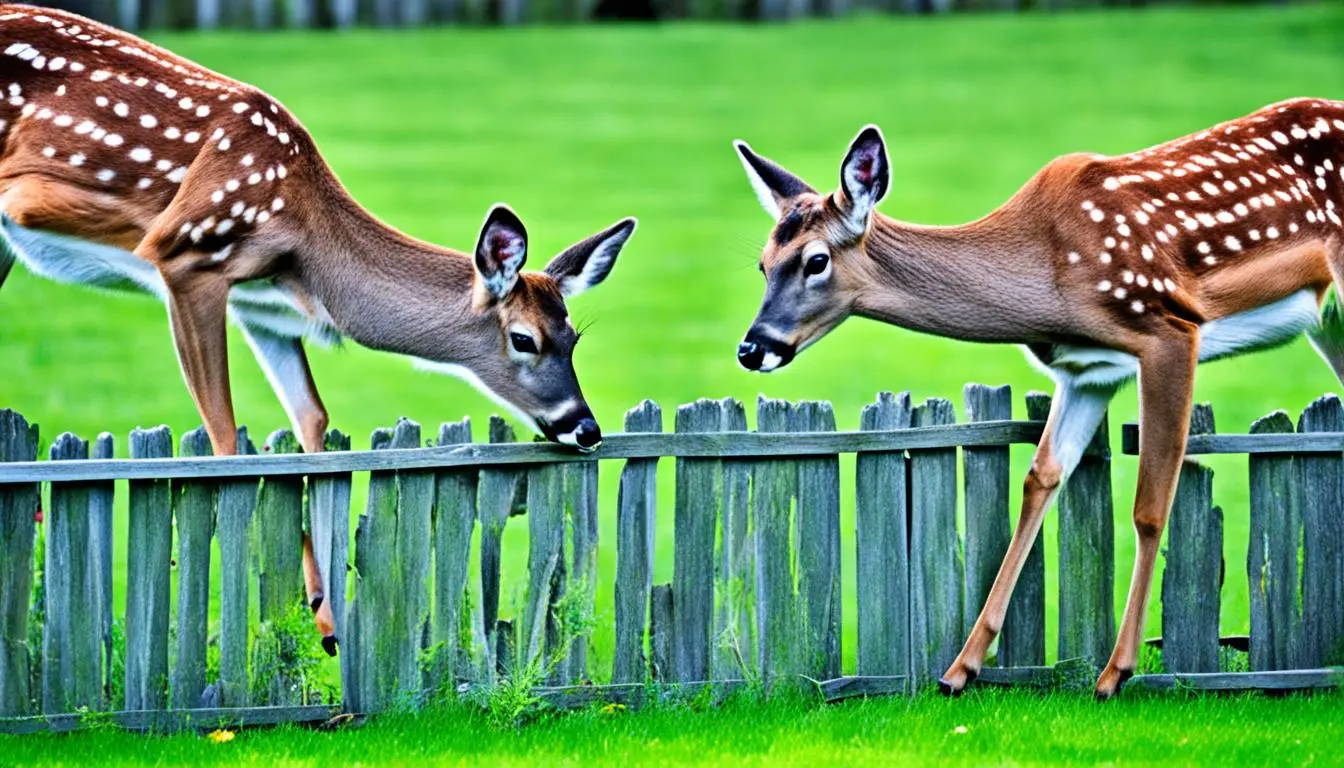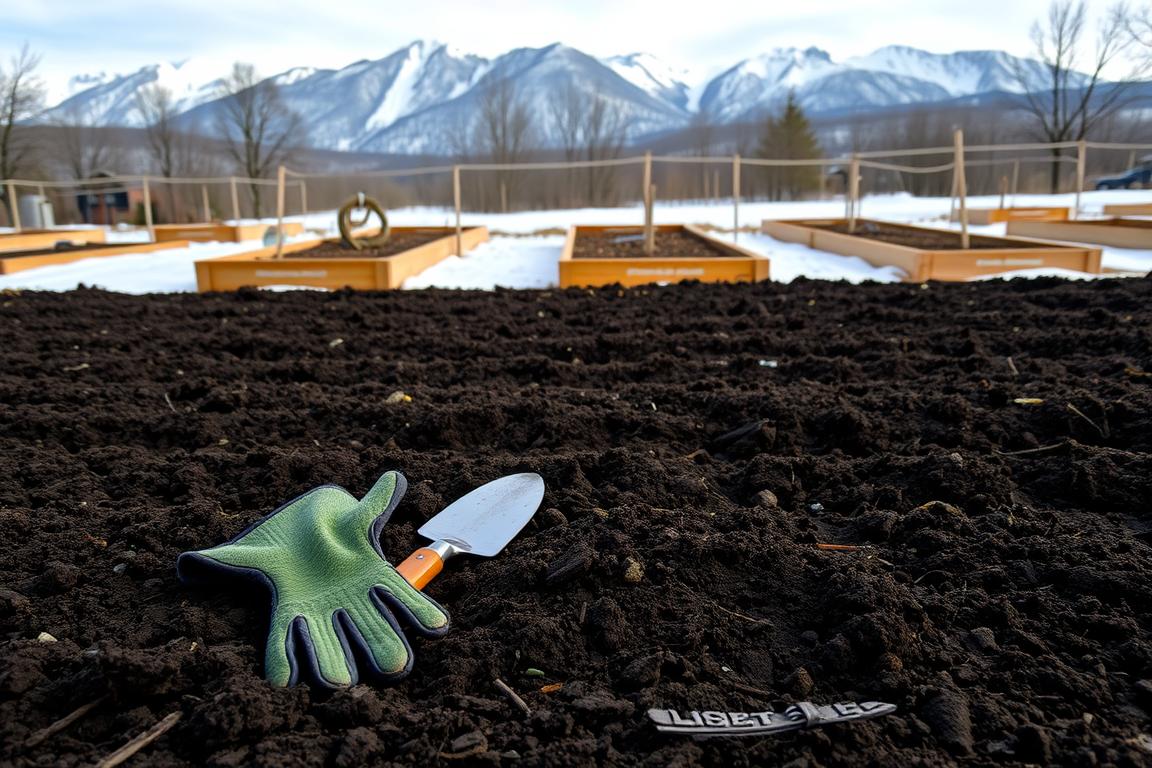Keeping deer out of your garden can be hard, but using many proven methods makes it easier. This guide dives into ways to understand deer behavior and deal with it. It suggests using deer fencing, deer repellents, and deer-resistant plants to keep your garden safe. By attacking the reasons deer come in with many strategies, you can stop deer damage.
Key Takeaways
- Understand deer behavior and habitat preferences to tailor deterrent strategies.
- Employ a combination of physical barriers, olfactory repellents, and visual scare tactics.
- Select deer-resistant plants and utilize companion planting techniques.
- Regularly maintain and adjust deterrent methods to keep deer at bay.
- Consult local experts for region-specific insights on effective deer control techniques.
Understanding Deer Behavior and Habits
Deer thrive in the mix of forests and open areas. This setting offers them a range of foods. They can smell well and find tasty plants in gardens. These plants include vegetables and fruits.
Deer can cover lots of ground looking for food. They often eat from gardens in cities and neighborhoods. A good smell can draw them to these places.
Deer Habitats and Feeding Patterns
Deer like many types of plants. They eat things like flowers, vegetables, and fruit. It’s smart to use different scents to keep them away from certain plants.
Homemade sprays can help scare deer off. These sprays give off strong, bad smells. Putting them on plants can protect your garden.
Attractants and Repellents
Effective Deer Deterrent Strategies
Using deer repellent sprays can keep deer away from your garden. These sprays are great when deer want to snack on young plants. They often contain things like rotten eggs and essential oils. These scents and tastes are yucky to deer, so they stay away. Remember to reapply the spray, especially after it rains, to keep it working.
Repellent Sprays and Solutions
Deer can smell really well, and they don’t like certain scents. You can keep them out by putting smelly things around your garden. Ammonia-soaked rags and hot pepper sprays work well. You can also use bars of fragrant soap. These scare off deer because they don’t recognize the new smells. Another trick is to use predator urine, like coyote pee. This could trick deer into thinking a dangerous animal is nearby, so they stay away.
Scent Deterrents
Deer get scared easily by moving or noisy things. This makes noises and things that move great deterrents. Hanging strips of fabric that move in the breeze, wind chimes, and motion-sensor water sprinklers work well. They make the area seem unpredictable, which deer don’t like. Scarecrows that move or use sensors can also be helpful. They confuse deer by making them feel like they’re being watched.
Auditory and Visual Deterrents
Physical Barriers and Fencing
A tall fence is very effective at keeping deer out of your garden. Deer can jump well and clear barriers less than 8 feet high. So, a tall fence is needed. Other options include electric fencing, which shocks deer lightly to keep them away. Some people choose stockade fences because they look nice. But these fences must still be very tall. For smaller spaces, consider using chicken wire or plastic netting. This way, you can see through the barrier. If you’re really serious, a double-fence setup can confuse deer and keep them out.
Fence Types and Considerations
Tall fences, about 8 feet high, are best to keep deer away. Electric fencing is another option, shocking deer if they get too close. If you prefer something more traditional, stockade fences are great. Just make sure they are tall enough. For small areas, chicken wire or plastic netting is a good choice. It acts as a barrier but doesn’t block your view.
Strategic Garden Layout
The way you lay out your garden can help stop deer from coming in. Use plants that deer don’t like, such as herbs and flowers, all around the garden’s edge. This acts as a natural fence. Placing tall plants at the back and short ones at the front makes it harder for deer to get in. You can also put a fence around plants that deer love to eat. This protects your veggies from deer munching.
How to Keep Deer Out Of Your Garden: Top Plants and Companion Planting
Adding deer-resistant plants to your garden can keep deer away. Plants like lavender, giant marigolds, and catmint don’t appeal to deer. You can plant them around the garden to form a protective ring. This makes it harder for deer to reach your favorite flowers.
Aromatic Plants to Deter Deer
Deer dislike strong smells, which means certain plants can keep them out. For instance, lavender and dill give off odors that deer find off-putting. The scents of marigolds and yarrow also work well for this.
Companion Planting for Deer Resistance
Pairing deer-resistant plants with others can protect your garden. Like placing lavender near roses can discourage deer. The mix of smells and tastes can make your garden an unwelcome spot for them.
Adding taller, deer-resistant plants at the back and shorter ones at the front is a good idea. This layering approach confuses deer and helps protect your garden. Choosing plants deer don’t like, like salvias, is important for this strategy.

Scare Tactics and Local Knowledge
There are ways to keep deer away beyond just building fences. Scare tactics work too. You can hang shiny objects like shiny tape or metal strips in your yard. This can surprise deer and make them think twice about coming closer. But remember, deer may not stay scared of these shiny things forever.
It’s smart to talk to the local agricultural extension offices and master gardeners. They know a lot about the deer behaviors and likes in your area. This helps you use the best scare tactics for your location.
| Scare Tactic | Effectiveness | Considerations |
|---|---|---|
| Hanging Shiny Objects | Temporarily effective | Deer can become accustomed over time |
| Consulting Local Experts | Provides valuable regional insights | Helps tailor deterrent strategies |
Using a mix of scare tactics and knowing what local deer behavior is like can make your yard safer. It lets gardeners make the best choices in scaring deer away.
Choosing Deer-Resistant Plants
Choosing plants that deer don’t like is key to protect your garden. Some good choices are fragrant herbs like lavender and sage. Also, plants that hold a lot of moisture, such as lamb’s ear and Russian sage, keep deer away. These less tasty plants help shield the more delicate ones.
Make sure to check if the deer-resistant plants work in your area. Deer can have different likes depending on where they are. Picking easy-to-care-for plants that deer avoid lets you build a garden that’s safe from their nibbling.
Easy-to-Grow Deer-Resistant Plants
| Plant Type | Examples | Why Deer-Resistant |
|---|---|---|
| Aromatic Herbs | Lavender, Sage, Rosemary | Strong scents and flavors that deer generally find unpalatable |
| Moisture-Rich Plants | Lamb’s Ear, Russian Sage | Tough, fibrous textures and high moisture content that deer avoid |
| Ornamental Grasses | Fountain Grass, Switchgrass | Coarse, unappetizing foliage that deer typically leave alone |
| Flowering Perennials | Salvia, Yarrow, Coneflower | Pungent aromas and unpalatable textures that deter deer |
By mixing different deer-resistant plants, you can keep your garden safe. Thoughtful choices and where you plant them are key. This way, you can keep deer from your favorite plants with little effort.

Combining Multiple Deterrent Methods
The best way to keep deer out of a garden is to use several methods together. It’s about mixing different defenses like fences and scents. This layered approach uses both physical and nose-related ways to stop deer. These techniques play on the deer’s habits, making it more likely they’ll avoid your garden.
Conclusion
Keeping deer out of the garden is tough but doable. It needs a mix of tricks and some clever thinking. By knowing how deer act and what they like, gardeners can use lots of ways to keep them away.
From choosing plants they don’t care for to using smells and sights they dislike, you can save your garden. The real secret is to use a bunch of these methods together and change things up when needed.
No single way will always work, but mixing up your plan really helps. It means using different ways to make your garden deer-proof. And always staying alert and ready to switch things around keeps your garden safe.






